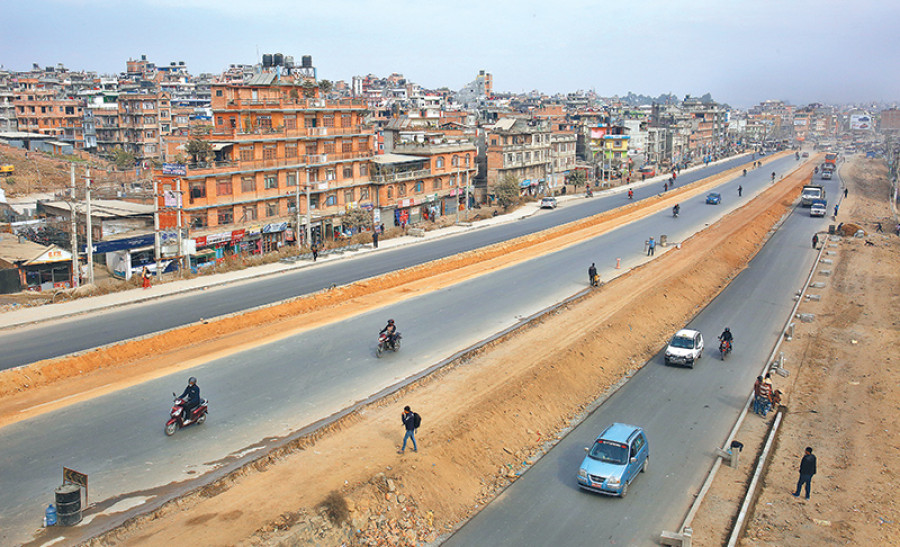National
Ring Road part ‘death trap’
In the past six months, eight deaths occurred in the eight-lane Kalanki-Koteshwor road section, according to the traffic police.
Anup Ojha
In the past six months, eight deaths occurred in the eight-lane Kalanki-Koteshwor road section, according to the traffic police.
Metropolitan Traffic Range Lalitpur data shows 213 accidents took place on the newly constructed road. From these 194 people received mild to serious injuries. Of the total accidents, more than 70 percent involved two-wheelers.
The traffic report marks the 100-metre periphery of the B and B Hospital in Satdobato as one of the most accident-prone areas. In the past six months, three people died and 78 received minor to major injuries in 37 accidents here.
Bijay Khadka, 37, vividly remembers an accident involving a motorcyclist who died on the spot, in front of B and B Hospital a month ago. The accident has traumatised him. He now fears riding his bike. He often feels nervous and anxious.
“The road is wide, but it looks more like a death trap. Every time I ride to office from this road, I remember the motorcyclist who died because of speed just below the overhead bridge, just in front of the hospital,” said Khadka, who lives near the hospital.
Speaking to the Post, B and B Hospital Administrator Purna Chandra Pradhan said the number of casualties has increased after the road opened.
National Trauma Centre (NTC), Mahankal, data on all kinds of accidents in Kathmandu shows 35 percent comprise road accidents and 37 percent people falling from roofs of houses or buildings.
NTC Chief Medical Superintendent Dr Pramod Kumar Upadhya said,
“These accidents happen because of the lack of people-friendly road infrastructure in the Valley and the lack of awareness of road safety among people.”
The Ekantakuna chowk that links Bhainsepati and Jawalakhel witnessed two deaths and 30 injuries in 37 accidents in the past six months.
The road between Nakkhu and Sanepa recorded two deaths and 75 injuries in 130 accidents.
The newly constructed bridge in Koteshwor witnessed one death. The section between Koteshwor and Balkumari Bridge has seen nine accidents that injured 11 people, Koteshwor Traffic Police Circle official said.
Lalitpur Traffic Police chief Sitaram Hachhethu said, “Our officers strictly monitor roads, but the road infrastructure is too dangerous for pedestrians and motorcyclists.”
He said absence of road dividers, traffic lights and zebra crossings, night lights, parking stations, and inadequate overhead bridges along the roads are the major causes of the accidents, besides drivers’ negligence.
This road section has three overhead bridges—one in Koteshwor, one in front of the B and B Hospital and, the third in Sanepa area.
“These bridges are inadequate. If infrastructure is not built as scheduled, there is not much the traffic department could do to solve the problem. This section has seen many hit-and-run cases. On an average, traffic police record three such cases every day. Police cannot trace and arrest hit-and-run motorists because there is no CCTV,” said Hachhethu.
The spate of fatal accidents invited critical censure after public outcry. Critics, activists and eminent citizens criticised the project’s galling lack of safety measures. Most described the road section as a “death trap”.
Urban Planner and a former government secretary Kishor Thapa concurs with the criticism.
“The road looks more like an expressway. This road section has to be made into a proper urban road, with separate lanes for pedestrians, cyclists, zebra crossings, fast and slow lane markings for vehicles. The section lacks these features,” said Thapa.
The mobility of people outside the Ring Road has increased in Kathmandu; there are many intersections such as in Balkhu, Sanepa, Ekantakuna, Satdobato, Gwarko and Balkumari that lead to bigger settlements.
Thapa further said the traffic department alone cannot solve the problem. “The contractor should review the infrastructure and seriously consider public safety with increased mobility,” said Thapa.
Chinese firm Shanghai Construction Group started the project in 2013 for the road section, in the first phase of the project.




 7.12°C Kathmandu
7.12°C Kathmandu.jpg)















